One hundred and fifty years ago today, on December 2, 1863, the United States Capitol Dome was completed, adding its own distinctive grandeur to the skyline of our Nation’s capital city.
Last month in November 2013, a two-year project began to restore the aging dome. Read all about it on the Architect of the Capitol’s website about the US Capitol Restoration Project at http://www.aoc.gov/dome.
While most of the focus on the Capitol these days pertains to politics, this anniversary is an appropriate time to reflect on the art and architecture of one of our National Treasures, the US Capitol, along with the artists, architects and engineers who helped make it a showplace worthy of a world class city. Following are a few of the more outstanding publications about the US Capitol art and architecture.
Glenn Brown’s History of the United States Capitol
 Prepared for the Bicentennial of the construction of the United States Capitol in 1994, Glenn Brown’s History of the United States Capitol is the definitive history of the construction of the Capitol, including the many trials and tribulations along the way, such as the burning of the Capitol by the British in August 1814 during the War of 1812.
Prepared for the Bicentennial of the construction of the United States Capitol in 1994, Glenn Brown’s History of the United States Capitol is the definitive history of the construction of the Capitol, including the many trials and tribulations along the way, such as the burning of the Capitol by the British in August 1814 during the War of 1812.
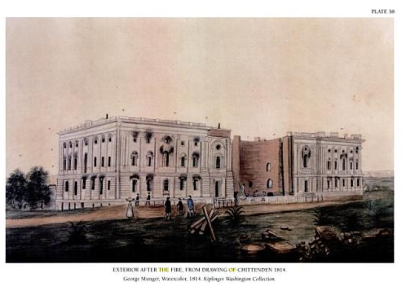 Image: US Capitol exterior after the fire from the British burning of Washington. From Glenn Brown’s History of the United States Capitol
Image: US Capitol exterior after the fire from the British burning of Washington. From Glenn Brown’s History of the United States Capitol
Capital Engineers: The US Army Corps of Engineers and the Development of Washington DC, 1790-2004
In his introductory address kicking off the second inauguration of President Barack Obama and Vice President Joseph Biden on January 21, 2013, Senator Schumer (D-N.Y.) remarked on the completion of the Capitol Dome 150 years ago—just two years ahead of President Lincoln’s second inauguration on March 4, 1865:
“When Abraham Lincoln took office [in 1861], two years earlier the dome above us was a half-built eyesore… Conventional wisdom was that it should be left unfinished until the war ended, given the travails and financial needs of the times. But to President Lincoln the half-finished dome symbolized the half divided nation. Lincoln said, ‘If people see the Capitol going on it is a sign we intend the union shall go on.’ And so, despite the conflict which engulfed the nation, and surrounded the city, the dome continued to rise.”
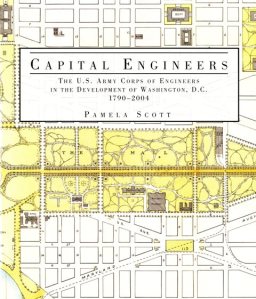 The Army Corps of Engineers played a significant role in the design and construction of the Capitol Dome and the rest of Washington, DC. In the enjoyable and anecdote-filled book entitled Capital Engineers: The U.S. Army Corps of Engineers and the Development of Washington, D.C. 1790-2004, readers can discover the politics, passion, inspiration and innovation that went into crafting the landmark historic monuments, public buildings and infrastructure that makes up the Nation’s capital, including sketches and insider stories about the design and construction of the United States Capitol and Dome.
The Army Corps of Engineers played a significant role in the design and construction of the Capitol Dome and the rest of Washington, DC. In the enjoyable and anecdote-filled book entitled Capital Engineers: The U.S. Army Corps of Engineers and the Development of Washington, D.C. 1790-2004, readers can discover the politics, passion, inspiration and innovation that went into crafting the landmark historic monuments, public buildings and infrastructure that makes up the Nation’s capital, including sketches and insider stories about the design and construction of the United States Capitol and Dome.
You can read the detailed review of this fun and fact-filled book under our earlier blog post, The Untold Story Behind the Engineering of Washington DC. 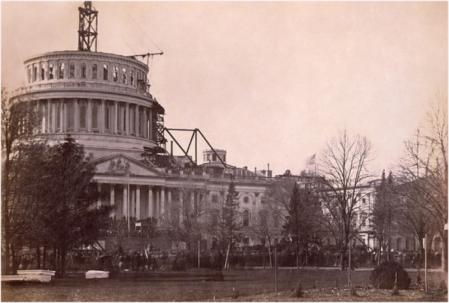 Image: First Inauguration of Abraham Lincoln, March 4, 1861, beneath the unfinished Capitol dome. Source: Library of Congress
Image: First Inauguration of Abraham Lincoln, March 4, 1861, beneath the unfinished Capitol dome. Source: Library of Congress
NEW! To Make Beautiful the Capitol: Rediscovering the Art of Constantino Brumidi
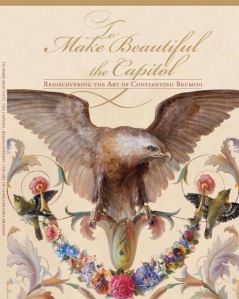 Once the Dome was completed, it was decided that it needed to be a showcase of the finest art. For those visitors lucky enough to come to Washington, DC, and take a tour of the Capitol, they marvel at the “monumental fresco” in the Capitol Rotunda, called The Apotheosis of Washington, that reminds one of the Sistine Chapel and the incredible frescoes along the walls and ceilings of the corridors and special rooms, such as the President’s Room.
Once the Dome was completed, it was decided that it needed to be a showcase of the finest art. For those visitors lucky enough to come to Washington, DC, and take a tour of the Capitol, they marvel at the “monumental fresco” in the Capitol Rotunda, called The Apotheosis of Washington, that reminds one of the Sistine Chapel and the incredible frescoes along the walls and ceilings of the corridors and special rooms, such as the President’s Room.
In this stunning new publication, To Make Beautiful the Capitol: Rediscovering the Art of Constantino Brumidi, the United States Senate Office of the Curator provides an updated history of the work on the Capitol by Italian-born artist, Constantino Brumidi, who spent the last 25 years of his life making the Capitol into an awe-inspiring piece of art worthy of his own native land’s masterpieces with his frescoes and decoration of the walls and ceilings. Includes new discoveries about the artist, his inspirations and genius resulting from recent extensive restoration of his work to its original glory.
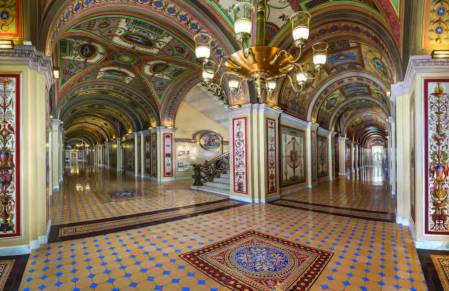 Image: The Brumidi Corridors, from To Make Beautiful the Capitol: Rediscovering the Art of Constantino Brumidi
Image: The Brumidi Corridors, from To Make Beautiful the Capitol: Rediscovering the Art of Constantino Brumidi
United States Senate Catalogue of Fine Art
 Visitors to the finished Capitol are often surprised by both its stunning architectural details and the impressive art complementing the interior spaces. Now, those works of art–ranging from portraits of prominent senators to depictions of significant events in U.S. history–are accessible to everyone through the publication of the United States Senate Catalogue of Fine Art. Prepared by the Office of Senate Curator, the catalogue represents the first comprehensive effort to illustrate and interpret this rich collection of 82 sculptures, 75 paintings, 2 enameled mosaics, and 1 stained glass window.
Visitors to the finished Capitol are often surprised by both its stunning architectural details and the impressive art complementing the interior spaces. Now, those works of art–ranging from portraits of prominent senators to depictions of significant events in U.S. history–are accessible to everyone through the publication of the United States Senate Catalogue of Fine Art. Prepared by the Office of Senate Curator, the catalogue represents the first comprehensive effort to illustrate and interpret this rich collection of 82 sculptures, 75 paintings, 2 enameled mosaics, and 1 stained glass window. 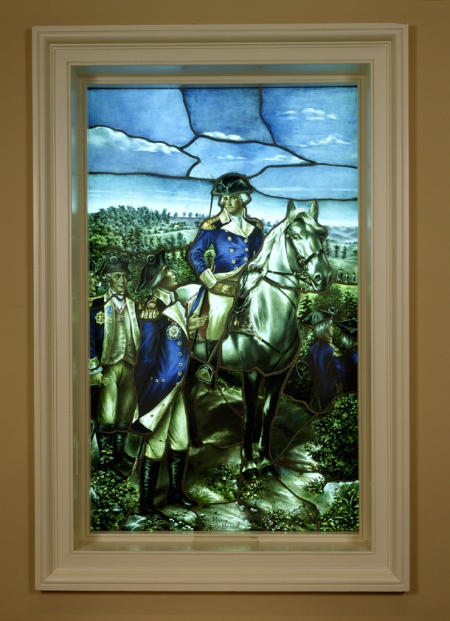 Image: Stained glass George Washington Memorial Window, by Maria Herndl in 1904, from United States Senate Catalogue of Fine Art
Image: Stained glass George Washington Memorial Window, by Maria Herndl in 1904, from United States Senate Catalogue of Fine Art
The 160 pieces in the catalogue represent the work of 111 artists, including such celebrated figures as Gilbert Stuart, Alexander Calder, Augustus Saint-Gaudens, Thomas Sully, and Daniel Chester French. Many of the works feature prominent senators, including portraits of Everett McKinley Dirksen, Mike Mansfield, and Robert A. Taft, and small bronze sculptures of Henry Clay and Daniel Webster.
A majority of the people depicted are immediately recognizable, such as George Washington, Thomas Jefferson, Theodore Roosevelt, and Benjamin Franklin, but there are also lesser-known figures include the Ojibwa Indian Chief Be Sheekee (Buffalo) who was in Washington to negotiate a peace treaty the year he died, and Senate employee Isaac Bassett, who came to the Senate in 1831 as one of the first pages and stayed until 1895, when he was an elderly doorkeeper.  Image: Marble bust of Indian Chief Be sheekee, or Buffalo, by sculptor Francis Vincenti in 1856
Image: Marble bust of Indian Chief Be sheekee, or Buffalo, by sculptor Francis Vincenti in 1856
Although portraits dominate the collection, the American landscape is represented by an oil painting of Niagara Falls in winter. Major events are also documented, such as the first reading of the Emancipation Proclamation by President Abraham Lincoln and the first manned moon landing. There are two special collections: a collection of vice presidential busts, and a series of paintings of major U.S. army posts completed by Seth Eastman.
Eastman Forts Print Set
In 1870, the House Committee on Military Affairs commissioned artist Seth Eastman to paint 17 images of important U.S. Army forts in the United States after the Civil War. He completed the works between 1870 and 1875. For many years, the fort paintings hung in the rooms assigned to the House Military Affairs Committee, first in the Capitol and later in the Cannon House Office Building. During the late 1930s, they were returned to the Capitol for public display. Of the 17 paintings, 8 are located today in the Senate wing. 
This Eastman Forts Print Set includes a booklet, “The Eastman Forts, A Guide to the Print Set,” and 10 color prints of Eastman paintings of the following ten forts: Fort Mackinac in Michigan; Mifflin in Pennsylvania; Trumbull in Connecticut; Tompkins and Wadsworth in New York; Scammel and Gorges in Maine; Delaware in Delaware; Snelling in Minnesota; Taylor in Florida; Defiance in New Mexico (now Arizona); and Fort Rice in North Dakota. 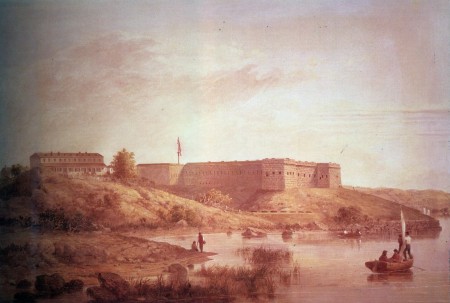 Image: A painting of Fort Trumbull, Connecticut, by Seth Eastman, commissioned by the U.S. Army in 1870, and hanging in the US Capitol. Part of the Eastman Forts Print Set.
Image: A painting of Fort Trumbull, Connecticut, by Seth Eastman, commissioned by the U.S. Army in 1870, and hanging in the US Capitol. Part of the Eastman Forts Print Set.
United States Senate Catalogue of Graphic Art
 Some of the art about the Capitol was not included in the building itself, but was produced outside of it by the press and media of the day. Prior to the advent of modern media with color photographs and live audio and video, Americans received their news and images from newspapers and illustrated news magazines, which included both hard news and softer features full of engravings, portraits, political cartoons, and illustrations.
Some of the art about the Capitol was not included in the building itself, but was produced outside of it by the press and media of the day. Prior to the advent of modern media with color photographs and live audio and video, Americans received their news and images from newspapers and illustrated news magazines, which included both hard news and softer features full of engravings, portraits, political cartoons, and illustrations.
The United States Senate Catalogue of Graphic Art reflects this coverage mix of both hard and soft news. The catalogue includes prints involving the Senate that depict important events of the day such as the debate over slavery, the impeachment trial of Andrew Johnson, and presidential inaugurations. But also featured are prints capturing the daily rhythms of the Senate such as the crowded Capitol corridors, Senate pages delivering documents, lobbyists pleading their case, meals in the Senate dining room, and idyllic scenes of the Capitol building and grounds.
 How can I obtain these publications about the US Capitol Art and Architecture?
How can I obtain these publications about the US Capitol Art and Architecture?
- Shop Online: You can purchase these publications from the U.S. Government Online Bookstore at http://bookstore.gpo.gov by clicking on the links above in this blog post or clicking here to shop our US Capitol Art publications.
- Order by Phone: Call our Customer Contact Center Monday through Friday, 8 am to 5:30 pm Eastern (except US Federal holidays). From US and Canada, call toll-free 1.866.512.1800. DC or International customers call +1.202.512.1800.
- Shop our Retail Store: Buy a copy of any print editions from this collection at GPO’s retail bookstore at 710 North Capitol Street NW, Washington, DC 20401, open Monday–Friday, 9 a.m. to 4 p.m., except Federal holidays, Call (202) 512-0132 for information or to arrange in-store pick-up.
- Visit a Federal Depository Library: Search for one of these publications in a nearby Federal depository library.
About the Author: Government Book Talk Editor Michele Bartram is Promotions Manager for GPO’s Publication and Information Sales Division in Washington, DC, and is responsible for online and offline marketing of the US Government Online Bookstore (http://bookstore.gpo.gov) and promoting Federal government content to the public.

[…] With its famous dome celebrating its 150th anniversary in December 2013, the United States Capitol is a treasure-trove of civic art. Just released, To Make Beautiful the Capitol: Rediscovering the Art of Constantino Brumidi gives a detailed history of renowned Italian-born artist Constantino Brumidi’s masterful work in “making beautiful” the walls and ceilings of the United States Capitol in a span of 25 years starting in 1854. Every page delights with gorgeous, full-color photographs and images of Brumidi’s art, from photographs of the frescoes and decoration, to sketches, paintings and images of the artist, particularly the Brumidi Corridors and his “monumental fresco” in the Capitol Rotunda, called The Apotheosis of Washington. Fascinating anecdotes are included throughout of the artist and the inspirations he received for various elements, his relationship with engineer Montgomery C. Meigs, and the conservation efforts to preserve his work accurately for posterity. Read more about this publication and others about art in the Capitol in our prior blog post, National Treasure: The art and architecture of the US Capitol. […]
LikeLike
Way cool! Some extremely valid points! I appreciate
you writing this article plus the rest of the site is also very good.
LikeLike
Brumidi Corridors are breathtaking.
LikeLike
I agree! You should see them in person! Thanks for writing…
LikeLike
your site is very interesting for the architect
LikeLike
US Capitol : The Authentic of American.-
We all know that American people are multifarious: cultures, nations, and races. It’s contemplating of their journey that showed in This Building; how rose and how should reach the aim………!!!!
LikeLike